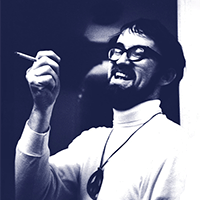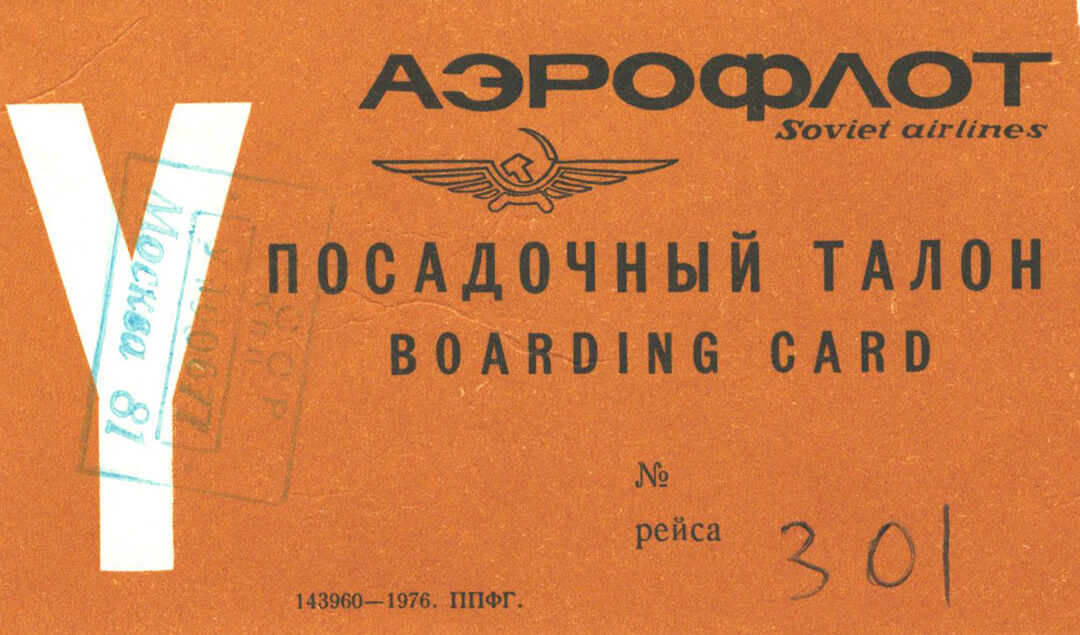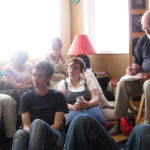Organizers against a large power line coming through northern New York and heading to New York City used to meet at a large home in Holland Patten, a small town north of Utica. I went there to play poker, just as I was getting ready to make my trip to the USSR in 1976. In the course of the game, I took most of a young woman’s money. Her name was Nahoe Curtet.
Nahoe held Swiss citizenship, but had grown up in Africa, the daughter of missionaries. After the game, we took a walk and I said she should come with me to the USSR. To my amazement, she said okay. We became lovers and about three weeks later we left for a month in the Soviet Union.
Nahoe and I flew from New York City to Moscow on an Aeroflot jet along with the other eleven members of our group. I presumed that most of our group belonged to the Communist Party, but one never asks directly. There were two, however, who said they were members and proud of it. Clarence and Nora lived in North Dakota. Clarence, at 85 years old, still wrote for the Daily Worker, the CP paper out of New York City, and Nora, a few years younger, had just retired from a career as a textile worker organizer. Clarence carried nitro pills to keep his heart going. He and Nahoe became close buddies since Nahoe’s nursing specialty was in cardiology. Just before Clarence bounded up the next set of stairs, Nahoe always reminded him to pop a couple of those nitro pills.
The flight took something like eleven hours or maybe more. It was certainly the longest, non-stop airplane flight I had ever been on. We came in over the Baltic Sea, as I remember, but we still had two hours to go. My legs were cramping.
Anniversary Tours out of New York City organized these tours. The CP and Anniversary Tours were connected somehow and the tours inexpensive. I paid $1100 for the entire month tour. The $1100 included airfares, hotels and meals. I brought along $600 in cash and only spent $300. There was nothing to buy, anyway, and the dollar stores sold the same items whether in Moscow or out east in Irkurtsh. I did buy some incredible women’s jewelry that looked more Ottoman than Russian.
I can’t remember much about Moscow in 1976 other than the high rise cement block housing projects and the truck traffic. The housing projects dotted the outskirts of the city and seemed disconnected from each other and from community life. I guess everyone got a home, but I didn’t want to live in one of those complexes. Commercial trucks dominated the highways and belched fumes like the exhaust came straight out of the manifold. I still remember it as an indicator of a “developing” country.
The Moscow subway or metro system was something else, however. It was beautiful and spotless. The contrast with the New York City subway system could not have been greater. The Moscow system was like several spoked wheels on top of each other. Each wheel was a different metro line. If you wanted to transfer to a new line, you went up or down the hub at the center of the system. The amazing thing to me about the system, however, was that it was spotless. There was not even a cigarette butt on the floor, let alone any graffiti. Plus, each station was like an art museum, although I can’t remember what was actually in the “museum.” It was impressive, although I have no idea whether it served as an efficient transportation system for Moscovites or served as merely a Soviet showcase.
The Communist Party assigned a young party member as our guide, but we learned while in Moscow that he had taken sick and could not go. A young Jewish woman took his place, a non party member. Shevna was bound and determined to show us that this old Soviet bureaucracy was flexible and would respond to our needs. Maybe she was also proving it to herself. She stayed with us our entire month. She had also never been out east to the Central Asia republics or to Irkutsk where the Czar had driven the Decembrists. Shevna was a fan of the Decembrists, turn of the century, parliamentary reformists who got to live if they could walk to Irkurtsk. Many didn’t make it.
We spent several days in Moscow on guided tours. Most of the sites were churches. After a couple of days of this touring, a very frustrated Clarence shouted out to the tour guide, “We don’t want to see any more churches! Turn around and look at us. We’re all atheists. We don’t want to see churches; we want to see the Revolution!”
Clarence had been working on and hoping to see the revolution his entire life and now was his chance. He wanted to meet with trade union leaders, visit collective farms, look at the health care system, speak with communist party leadership. It didn’t occur to me that we were here to see the Revolution, but I was fine with it. After all, this was not an “In-tourist” tour, a managed, regular tour to the USSR. We were political folks and wanted to be treated as such, not just your average tourist.
For me, I wasn’t looking for the revolution. Turks were my interest. Fifty million Turks lived in the Central Asian republics and I wanted to see them and compare their lives to those in Turkey where I had served in the Peace Corps just ten years before. I wanted to speak Turkish and play some backgammon. Nevertheless, Shevna certainly got the message. She began demanding to see what had been scheduled for each of our tours and then checking with us if it was okay.
We flew out of Moscow and basically flew from one major city to another. We stopped in Bukara and Taskkent in Uzbekistan. Alma Ata in Kazakistan. Irkutsk on Lake Baikal and Bratsk on the Angara River before returning to Moscow.
Our first meeting with Soviet officialdom took place in the city of Taskent in Uzbekistan. The Soviet American Friendship Society invited us to meet with them. We got together as political people do and elected Sol as our group spokesperson. Sol was a man in his 50s from New York City and a party member. The Society’s building was beautiful and the Director, our host, was charming, suave and fluent in English.
At the conclusion of our tour of his facility, the Director invited us into his formal office for some tea. He sat behind his big desk and we arranged ourselves in various formal chairs and waited for whatever was supposed to happen next. The Director finally broke the awkward silence as we waited for the tea to arrive. “You have been on your tour for over a week now,” he said. “How has it been going?”
We relaxed. We were organized. Sol would answer and, indeed, Sol did answer. “We are really enjoying our stay in Russia and we want to thank you very much for your friendship and hospitality,” Sol replied. We all shook our heads in agreement. Nice job, Sol, we all thought, very diplomatic.
To our dismay, our host seemed startled by Sol’s comment. The Director sat back for a short while in his chair, then cleared his throat and sat forward over his desk and spoke to us in a very even, but precise manner, like a school mistress to her children. “I am glad you are enjoying your stay,” he said, “but,” he said, “you are not in Russia; you are in Uzbekistan. That’s why we call it the Union of Soviet Socialist Republics.”
When we got out of there, we had another political meeting and, as political people do, we got rid of Sol as our spokesperson for making a mistake that we all would have made, but didn’t. The group elected me as the new spokesperson. Better to have a complete dummy, than a party member.
I started seeing Uzbek, as opposed to Russian. The Uzbec people are a beautiful chocolate brown color. The men wear these colorful pill box hats that sat down on their heads. The hats were made of woven cloth and had flashy, tiny mirrors decorating the sides to ward off the evil eye. The women too wore bright colorful clothing, but, of course, were not veiled, as women in Turkey would be. The Soviets outlawed the veil when they defeated the Basmachi resistance in the late 1920s.
We went to a nice restaurant for dinner in Taskent, a large modern city in Uzbekistan. A very tall, statuesque blond Russian woman greeted us and ushered us to our table. The waitresses were creamed skinned women who came from the Baltic republics. As is the custom in many Turkish restaurants, we stood up and took a tour of the kitchen to see what’s available for dinner. Here is where we saw the Uzbecks. It was a sea of brown skinned people doing all the work, preparing the food, working over the stoves, washing up the dishes. You get the picture. I started seeing Russian cultural imperialism, rather than a Soviet system and started to understand the Director’s insistence that we understand where we were.
Besides being in Central Asia, we were also in the region of the world that sent thousands of soldiers to defeat Hitler. It wasn’t just Russians that died in the slaughter. A central part of almost every city I remember was a World War II war memorial. The memorial was not just ancient history, but the Soviets integrated World War II into civil society via the marriage ceremony. After couples made their vows in front of civil authority, they paraded or drove to the WWII war memorial as part of the wedding ceremony.
I can’t remember which city we were in, but our group headed for a tour of the ancient city citadel, now a museum. Nahoe and I were out front and reached the top of a steep, narrow, cobblestone walkway before the rest of the group. I asked the guard for tickets to the Museum and he said I could not enter. I asked why. He said it was my shirt. I was wearing a sleeveless t-shirt. We called it a ginny shirt in Brooklyn, a wife beater shirt. I know shirts like this can be offensive in places like churches or mosques. I offered to wear something over my t-shirt even though this place was a civil fortress. No luck. No ticket.
Nahoe and I turned around in the walkway and waited for our group to show up. Nora arrived first. “I can’t go in,” I told Nora. “Why not?” she said. I told her about the shirt. She said, “Dan, if you are not going in, none of us are going in.” I said, “Nora, I don’t care that much. Let it go.” “It’s not something we can let drop,” she said. “You’re our spokesperson. We elected you. If you don’t go, we don’t go”
When the rest of the group arrived, Nora told them the situation. I assumed we’d head back down the hill and find something else to visit. This is not what happened. Nora said everyone should sit down in the pathway until this thing gets resolved. It was a hot day. Most of this group were in their mid-sixties. The cobblestone was uneven and uncomfortable and I was not a party member. Nevertheless, much to my surprise, everyone sat down and Svena began negotiations. We went from the Guard to the Museum Director to the Central Committee of the city’s Communist Party. After two hours or so, we all entered the museum and I was wearing my ginny shirt.
We visited the industrial, frontier city of Bratsk on the Angara River. The Angara was the equivalent to the Columbia and the hydro electric project at Bratsk was like Grand Coulee Dam in eastern Washington State. Bratz was laid out in a circle with industrial neighborhoods on different points on the circle. Each industrial neighborhood had housing, a market and maybe a theater or cultural center for entertainment. Each industrial center also related to a particular industry. One center provided the workers for the hydroelectric project. Another center worked in the forest industry that harvested the tigra forests. I remember them telling me that it would take 80 years to cut down the tigra forests, but, by that time, they would have grown back so the harvest was basically renewable.
Nahoe and I wanted some time to ourselves so we went to the one restaurant for dinner. As we finished our meal, this large group of Mongolian workers came in all dressed up in their finest. It was a retirement party and they planned dinner and drinks. I greeted them in my best Turkish. I’m sure it sounded like gibberish to them, but since I was a kid I wanted to relate to Mongolians, Ghengis Khan was a favorite of mine.
Nahoe and I watched a movie that night in the Bratsk movie theater. It was your basic black and white, but it was about the Vietnam war. Guess who the heroes were? The Vietnamese! What a switch. I didn’t expect it, could not have imagined it, but there it was. The U.S. soldiers were the bad guys.
When we got back to the restaurant to check in with the Mongolian retirement party, most of the folks in their nicely fitted western suits were face down on the dinner tables and completely passed out from vodka. It was a strange scene.
Nahoe and I flew back to New York City together, but there our paths separated. She flew on to Utica, New York and I got a plane to Ithaca. Our poker party hostess said I broke Nahoe’s heart, but I never saw her again. It was not possible. I could not bring her back to Ithaca and I could not go to Utica.



